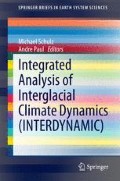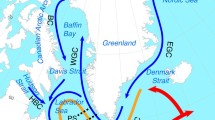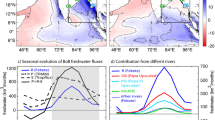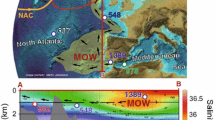Abstract
The dynamics of the Loop Current (LC) in the Gulf of Mexico (GoM) during transient climates and interglacials, and its interaction with changes in sea level, atmospheric circulation, and Mississippi River (MR) discharge were studied. Geochemical proxy records and numerical modeling indicate that LC eddy shedding and its related heat transport into the GoM increased during the deglaciation. The model simulations imply decreased LC eddy shedding at lowered sea levels, while transports through Yucatan and Florida straits increased due to the southward migration of the Intertropical Convergence Zone (ITCZ) and increased wind-driven transport in the North Atlantic. Consistent with the model, (isotope) geochemical proxy records from the northern GoM show glacial/interglacial amplitudes significantly larger than in the Caribbean and extreme cooling during the Last Glacial Maximum (LGM) due to the vanishing LC eddy shedding. Prominent deglacial melt water releases observed south and west of the MR delta are neither present in the northeastern GoM, nor in sea-surface salinity-records in the subtropical North Atlantic. The freshwater signals were either a regionally restricted phenomenon or due to changes in the isotopic composition of the discharged water. Our results question the impact of MR megadischarges on the large-scale overturning circulation.
Similar content being viewed by others
Keywords
- Loop current
- Eddy shedding
- Gulf of Mexico hydrography
- Mississippi discharge
- Interglacials
- Florida straits
- Yucatan channel
- Caribbean
1 Introduction
The Loop Current (LC) is the most prominent surface circulation feature in the Gulf of Mexico (GoM) flowing from the Caribbean through Yucatan Channel and Florida straits into the North Atlantic. Hence, the LC is a component of both, the western boundary current system of the North Atlantic and the basin- to global-scale meridional overturning circulation. It is therefore key to both present and past changes in the wind-driven basin-scale subtropical gyre and the global thermohaline circulation (e.g., Bryden et al. 2009; Lippold et al. 2012).
Special to the LC is the aperiodic shedding of anticyclonic meso-scale eddies, on time scales of 3–18 months (cf. Fig. 1a–c). The dynamics of the LC, in particular the mechanism of eddy separation and its possible link to external forcing (e.g. sea level and wind changes) is still not clear yet, but its role for the large-scale circulation in the North Atlantic is likely of importance (Mildner 2013). The focus of this study is therefore to understand the behavior of the LC and its eddy shedding during the past, in particular during transitional climate stages at the beginning of interglacials characterized by different sea level, atmospheric circulation, and wind stress forcing.
a–c Eddy separation process in CONTROL shown by sea-surface elevation (in meters) depicted as composite from the last 20 model years (18 events in total); contour lines are 0.8 (1.2 m with 10 cm interval). a Scenario 3 months before shedding; b the eddy has just separated from the LC; c scenario 6 months after shedding. Locations for sediment cores MD02-2575/-76, M78-181-3, EN32-PC6, KNR166-2-26, ODP-1058C, and ODP-999 discussed in the text are indicated. MR Mississippi River, LC loop current, FS Florida straits, YC Yucatan channel, BOR Blake outer ridge. d Time series of spatially averaged current speed (in m/s) at 200 m water depth averaged across the region given by 22°N–24°N and 87°W–84°W, i.e., northwest of the Yucatan Channel. Black line present-day reference simulation. Red line experiment with sea level lowered by 67 m; green line experiment with sea level lowered by 110 m, blue line experiment with sea level lowered by 200 m. Black arrow marks the shedding period of an eddy (Tshed). The sharp decreases in speed correspond to eddy shedding from the LC. Note that for better visualization CONTROL-67 was shifted by 0.2 m/s, CONTROL-110 by 0.4 m/s and CONTROL-200 by 0.6 m/s, respectively
Together with the LC, the Mississippi River (MR) discharge influences the GoM surface hydrography. Flower et al. (2004) described distinct negative excursions in planktonic foraminiferal stable oxygen isotopes (δ18O) during Heinrich Event 1 and the Bølling/Allerød, which suggest Laurentide melt water discharge events into the GoM (e.g., Flower et al. 2004), although their large-scale impact on the Atlantic meridional overturning circulation (AMOC) remains ambiguous. Using paleoproxy records we study how these flooding events distribute in the GoM and adjacent ocean areas.
2 Materials and Methods
We discuss proxy data from the northern GoM (cores MD02-2575, MD02-2576, M78-181-3), Florida Straits (core KNR166-2-26), and Blake Outer Ridge (ODP Site 1058C) (Fig. 2). Details on the chronostratigraphies are given here and in Nürnberg et al. (2008), Kujau et al. (2010), Bahr et al. (2013), and Schmidt and Lynch-Stieglitz (2011).
Deglacial development of the LC and the MR discharge. Left GoM SSTMg/Ca record of IMAGES core MD02-2575 (rosé, 29°00.10′N, 87°07.13′W, 847 m depth) from DeSoto Canyon reflecting deglacial warming of the northeastern GoM in response to the northward migrating LC eddies (this study; Nürnberg et al. 2008; Ziegler et al. 2008) in comparison to (i) the Caribbean SSTMg/Ca record of ODP Site 999 (brown, 12°45'N, 78°44'W, 2827 m depth, all measured on the planktonic foraminifer G. ruber white; see Nürnberg et al. 2008), (ii) the potassium (K) record of IMAGES core MD02-2576 (light blue, 29°00.09′N, 87°07.14′W, 848 m) approximating terrigenous supply from the MR (Kujau et al. 2010), and (iii) the Waelbroeck et al. (2002) relative sea level curve (black). The stable oxygen isotope (δ18O in ‰ VPDB) record of Greenland ice core NGRIP is used for stratigraphical control (dark gray). Right Various δ18O ivf−sw records approximating SSS changes from the northern GoM (MD02-2575, red, this study; M78-181-1, orange, 29°00.00′N, 88°20.00′W, 803 m depth, this study; EN32-PC6, light blue, 26°56.8′N, 91°20.0′W, 2280 m depth, after Flower et al. 2004), Florida Straits (KNR166-2-26, green, 24°19.60′N, 83°15.40′W, 547 m depth, Schmidt and Lynch-Stieglitz 2011), and Blake Outer Ridge (ODP Site 1058, gray, 31°41.00′N, 75°26.00′W, 2984 m, Bahr et al. 2013). The blue hatched line marks the today’s δ18O sw value of the GoM (Lodico et al. 2006). Shaded areas indicate Heinrich Event 2 (H2), Heinrich Event 1 (H1), and the Younger Dryas (YD) cool event. Black and open triangles denote AMS14C-datings at IMAGES core MD02-2575 (Nürnberg et al. 2008) and core M78-181-3 (this study), respectively
Mg/Ca and δ 18O analyses were performed on the shallow-dwelling planktonic foraminifer Globigerinoides ruber white. Sea-surface temperature (SSTMg/Ca) was determined using a common calibration. δ18Oseawater was calculated combining foraminiferal δ18O and SSTMg/Ca and subsequently, corrected for global ice volume variations yielding δ18Oivf−sw as an approximation for sea-surface salinity (SSS).
To investigate the terrigenous input into the northern GoM, we performed high resolution X-ray fluorescence (XRF) scanning converted to weight-% by using bulk XRF measurements on selected samples. Potassium is used to infer MR sediment discharge (Kujau et al. 2010).
Numeric modeling concentrated on the impact of sea level and wind stress change on the LC and eddy shedding (Mildner 2013). We re-configured an existing eddy-permitting model of the North Atlantic for different sea levels and for different wind forcing. The model realistically reproduces today’s circulation (Eden and Böning 2002), in particular the LC and its eddy shedding (Mildner 2013; see also Fig. 1a–c). Sea level was lowered by 67 m (Younger Dryas), 110 m (LGM), and 200 m (sensitivity experiment), respectively. In addition, we applied wind forcing appropriate to the LGM to our model by adding wind stress anomalies with respect to recent climate from 6 different coupled LGM model simulations of the PMIP-II effort to the standard recent wind forcing of our model (Braconnot et al. 2007; Barnier et al. 1995). We did not change the surface heat flux and freshwater forcing of the model in order to concentrate on the response to wind and sea level changes only. We believe this modeling strategy is justified, since there is evidence for only small changes in the North Atlantic thermohaline circulation during the LGM (Lippold et al. 2012).
3 Key Findings
Our SSTMg/Ca and SSS records from the northeastern GoM (MD02-2575) reflect the temporal dynamics of the LC, its relationship to varying MR discharge, and the evolution of the Atlantic Warmpool (Nürnberg et al. 2008). SSTMg/Ca and SSS records from the northern GoM reveal glacial/interglacial amplitudes significantly larger than in the Caribbean (Fig. 2). We hypothesize that the extreme cooling of the northern GoM during the LGM by ~6 °C is a result of reduced LC eddy shedding and sluggish heat transport into the GoM. Considerable sea-surface freshening implies glacially enhanced river discharge.
The eddy-permitting model simulations support that LC eddy shedding was most likely absent during the LGM (Fig. 1). Lower sea level in the model (~110 and ~67 m) significantly reduces the number of eddies shed from the LC, as well as the oceanic heat transport into the GoM. With rising sea level, eddy shedding has gradually increased across the deglaciation and thereby, warmed the northern GoM up to its present state.
The simulated response to wind stress changes acts similar to the effect of sea level drop: A southward shift of the Intertropical Convergence Zone (ITCZ) and a strengthened atmospheric circulation during the LGM causes enhanced (wind-driven) Sverdrup transport within the Subtropical Gyre (Slowey and Curry 1995), leading to a strengthened Yucatan Channel and Florida Straits through flow. In response to the stronger transports, the eddy shedding decreases (Mildner 2013). Although PMIP models also simulate a stronger gyre circulation in the North Atlantic during the LGM, Lynch-Stieglitz et al. (2009) argue for a reduced Florida Straits transport during the LGM based on paleoceanographic proxy data pointing towards a contradiction, which needs further investigation.
A further effect of the changes in wind forcing in the model simulation is the southward expansion of the northern recirculation gyre in the North Atlantic Bight, and the southward shift of the zero line of wind stress curl. In response, both Gulf Stream and the Subtropical Gyre are shifted southwards (Mildner 2013). A highly dynamic Subtropical Gyre even during interglacial cool periods is suggested from ODP Site 1058C proxy data (Bahr et al. 2011, 2013) with a long-lasting subsurface warming during Marine Isotope Stage (MIS) 5 c-b, which most likely originated from intensified Ekman down welling in response to enhanced wind stress. The accumulation of warm and saline waters in the subsurface of the Subtropical Gyre might have contributed to the stabilization of northern hemisphere climate during MIS 5.
Across the deglaciation, the continuous increase in SSTMg/Ca in the northern GoM is accompanied by gradually decreasing fluvial sediment supply from the MR (Fig. 2), providing evidence that both the LC and the MR acted in concert. The deglacial SSS development, instead, is different: Prominent melt water signals (δ18Oivf−sw) during Heinrich 1 and the Bølling/Allerød (Fig. 2) are observed only in cores south and west of the MR delta. In the northeastern GoM, instead, neither our SSS reconstruction nor the potassium record point to significant melt water discharge (Fig. 2). Apparently, the prominent freshwater signals were either a regionally restricted phenomenon or are due to changes in the isotopic composition of the discharge events. Since the δ18Oivf−sw-record from Blake Outer Ridge is also devoid of such anomalies (Fig. 2), we question the importance of Laurentide Ice Sheet melt water routing via the MR for perturbing the AMOC.
During the Holocene, low potassium concentrations and positive δ18Oivf−sw-values point to a negligible MR discharge when compared to LGM conditions. The rather gradual decline in SSTMg/Ca in the northeastern GoM after ~6 thousand years (ka) before present (BP) (Fig. 2) is in line with an insolation-driven southward migration of the ITCZ, synchronous with the declining influence of the LC on the GoM hydrography. The decrease in SSS in the GOM is paralleled by wetter conditions over South Florida pointing to gradually increasing precipitation during the late Holocene.
References
Bahr A, Nürnberg D, Schönfeld J, Garbe-Schönberg D (2011) Hydrological variability in Florida straits during Marine isotope stage 5 cold events. Paleoceanography 26(2):PA2214
Bahr A, Nürnberg D, Grützner J, Karas C (2013) Millennial-scale versus long-term dynamics in the surface and subsurface of the western North Atlantic subtropical gyre during Marine isotope stage 5. Global Planet Change 111:77–87. doi:10.1016/j.gloplacha.2013.08.013
Barnier B, Siefridt L, Marchesiello P (1995) Thermal forcing for a global ocean circulation model using a three-year climatology of ECMWF analyses. J Mar Syst 6(4):363–380. doi:10.1016/0924-7963(94)00034-9
Braconnot P, Otto-Bliesner B, Harrison S, Joussaume S, Peterschmitt JY, Abe-Ouchi A, Crucifix M, Driesschaert E, Fichefet T, Hewitt C, Kageyama M, Kitoh A, Laîné A, Loutre MF, Merkel U, Marti O, Ramstein G, Valdes P, Weber SL, Yu Y, Zhao Y (2007) Results of PMIP2 coupled simulations of the mid-holocene and last glacial maximum—part 1: experiments and large-scale features. Clim Past 3(2):261–277. doi:10.5194/cp-3-261-2007
Bryden HL, Mujahid A, Cunningham SA, Kanzow T (2009) Adjustment of the basin-scale circulation at 26 degrees N to variations in gulf stream, deep western boundary current and Ekman transports as observed by the rapid array. Ocean Sci 5(4):421–433
Eden C, Böning C (2002) Sources of eddy kinetic energy in the Labrador Sea. J Phys Oceanogr 32(12):3346–3363. doi:10.1175/1520-0485
Flower BP, Hastings DW, Hill HW, Quinn TM (2004) Phasing of deglacial warming and laurentide ice sheet melt water in the gulf of Mexico. Geology 32(7):597–600
Kujau A, Nürnberg D, Zielhofer C, Bahr A, Röhl U (2010) Mississippi River discharge over the last ~560,000 years—indications from X-ray fluorescence core-scanning. Palaeogeogra Palaeocl 298:311–318. doi:10.1016/j.palaeo.2010.10.005
Lippold J, Luo Y, Francois R, Allen SE, Gherardi J, Pichat S, Hickey B, Schulz H (2012) Strength and geometry of the glacial Atlantic meridional overturning circulation. Nat Geosci 1–4. doi:10.1038/ngeo1608
Lodico JM, Flower BP, Quinn TM (2006) Subcentennial-scale climatic and hydrologic variability in the Gulf of Mexico during the early Holocene. Paleoceanography 21:PA3015. doi:10.1029/2005PA001243
Lynch-Stieglitz J, Curry WB, Lund DC (2009) Florida straits density structure and transport over the last 8,000 years. Paleoceanography 24(3):PA3209
Mildner TC (2013) Past and present ocean dynamics in the subtropical Atlantic. Dissertation, University of Hamburg. urn:nbn:de:gbv:18-64014
Nürnberg D, Ziegler M, Karas C, Tiedemann R, Schmidt MW (2008) Interacting loop current variability and Mississippi river discharge over the past 400 kyr. Earth Planet Sci Lett 272(1–2):278–289
Schmidt MW, Lynch-Stieglitz J (2011) Florida straits deglacial temperature and salinity change: implications for tropical hydrologic cycle variability during the Younger Dryas. Paleoceanography 26:PA4205. doi:10.1029/2011PA002157
Slowey NC, Curry WB (1995) Glacial/interglacial differences in circulation and carbon cycling within the upper western North Atlantic. Paleoceanography 10(4). doi:10.1029/95PA01166
Waelbroeck C, Labeyrie L, Michel E, Duplessy JC, McManus JF, Lambeck K, Balbon E, Labracherie M (2002) Sea-level and deep water temperature changes derived from benthic foramifera isotopic records. Quat Sci Rev 21(1–3):295–305. doi:10.1016/S0277-3791(01)00101-9
Ziegler M, Nürnberg D, Karas C, Tiedemann R, Lourens LJ (2008) Persistent summer expansion of the Atlantic warm pool during glacial abrupt cold events. Nat Geosci 1:601–605. doi:10.1038/ngeo277
Acknowledgements
This work has been financed by the German Research Foundation (DFG) in the framework of the SPP1266 INTERDYNAMIK and IMAGES programs. Sample material was partly provided by the Integrated Ocean Drilling Program. The model integrations have been performed at University Kiel and Deutsches Klimarechenzentrum (DKRZ), Hamburg.
Author information
Authors and Affiliations
Corresponding author
Editor information
Editors and Affiliations
Rights and permissions
Copyright information
© 2015 The Author(s)
About this chapter
Cite this chapter
Nürnberg, D., Bahr, A., Mildner, T., Eden, C. (2015). Loop Current Variability—Its Relation to Meridional Overturning Circulation and the Impact of Mississippi Discharge. In: Schulz, M., Paul, A. (eds) Integrated Analysis of Interglacial Climate Dynamics (INTERDYNAMIC). SpringerBriefs in Earth System Sciences. Springer, Cham. https://doi.org/10.1007/978-3-319-00693-2_10
Download citation
DOI: https://doi.org/10.1007/978-3-319-00693-2_10
Published:
Publisher Name: Springer, Cham
Print ISBN: 978-3-319-00692-5
Online ISBN: 978-3-319-00693-2
eBook Packages: Earth and Environmental ScienceEarth and Environmental Science (R0)






